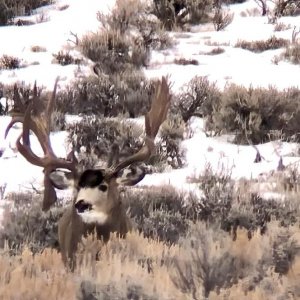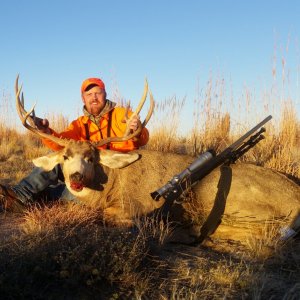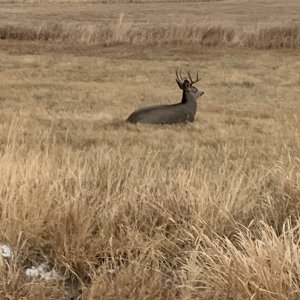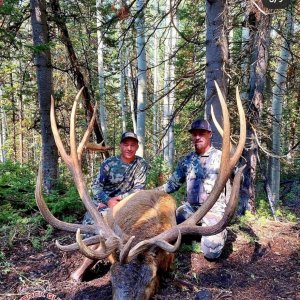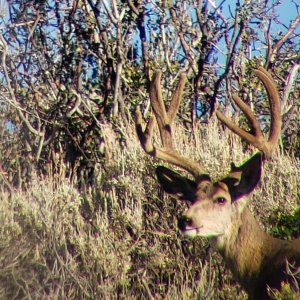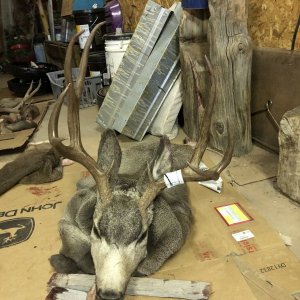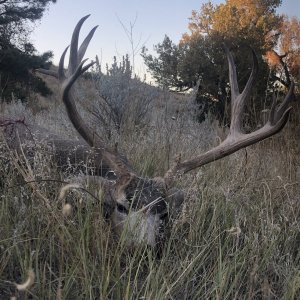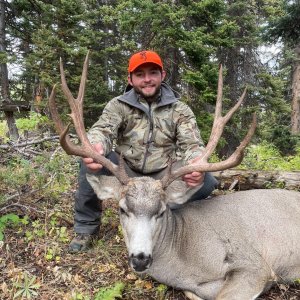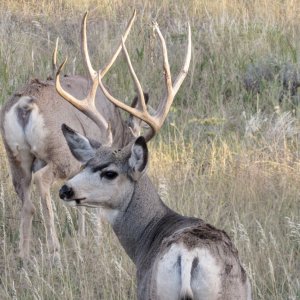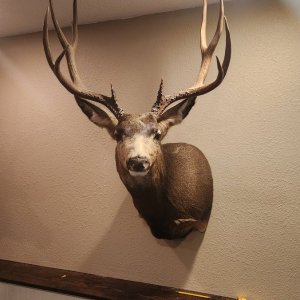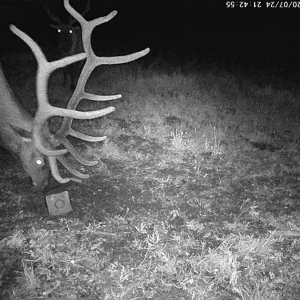cheeseheadinOHIO
Active Member
- Messages
- 490
Jan 4, 2:09 PM EST
DNR: Elk herd in northern Wisconsin growing again, ever so slowly
By ROBERT IMRIE
Associated Press Writer
Advertisement
WAUSAU, Wis. (AP) -- An elk herd started in northern Wisconsin more than a decade ago is growing again - slowly - in part because wolves have killed far fewer of the majestic animals during the last two years, a state wildlife biologist says.
The latest count puts the herd at about 130 elk, the most ever, said Laine Stowell of the state Department of Natural Resources.
"We grew 13 percent," he said. "We are growing out of those doldrums we had in 2004 and 2005."
That happened despite far more elk calves being killed by bear and continued vehicle crashes, Stowell said.
"If we grow at 13 percent a year for the next several years, we will reach 200 in 2011. If we can boost that up to about 20 percent a year, we will reach that point in 2009," he said.
Regulations already in place allow a bow hunting season in December for bull elk once the herd reaches 200 animals.
In 1995, 25 elk from Michigan were released in Chequamegon National Forest near Clam Lake to determine if the animals, which are bigger than deer, could become established again without damaging private land or causing problems for other wildlife.
Wisconsin's last native elk was shot in 1866, researchers said.
Some supporters had predicted the herd could grow to 500 by 2008.
Tom Toman, director of conservation for the Rocky Mountain Elk Foundation in Missoula, Mont., said the growth progress of the herd was disappointing.
"You would think that once they get to 100 (elk) everything would be hunky-dory, but the wolves have found them, and the bears have found the calving areas. That's to be expected," Toman said.
It might have been better to have started with a base herd of more than 25 elk, and adding some now would be good to give it "a little better jump start," he said.
But the discovery of chronic wasting disease in whitetail deer in southern Wisconsin a few years ago halted all talk of importing elk into the state, Toman said.
A few years ago, plans called for re-establishing elk in Jackson County, too, but the discovery of the always-fatal brain disease has scrapped that project, too, because there is no live animal test for the ailment, Toman said.
It will take patience to grow the elk herd, Toman said, pointing out that the U.S. had fewer than 100,000 elk a century ago. Today, 26 states have elk herds totaling about 1 million animals.
Jack McGregor, 57, of rural Clam Lake, has watched the Wisconsin herd since it was first introduced, and a couple of years ago he knew biologists were worried about its stagnant growth.
But those concerns have eased, he said.
"They are doing well," McGregor said. "I have never run across somebody who dislikes the elk. Early September is when they bugle. That is sort of neat when you hear that - and when you see them in the woods."
Between 1995 and 2003, about 30 percent of the elk calves born in the spring didn't survive, Stowell said. The mortality rate jumped to 50 percent in 2004 and 2005 - in part due to a parasite disease linked to artificial feeding of elk. The number of young bulls being killed by wolves was also up, stalling the growth of the herd.
Things are back on track, with 23 of the 35 calves born last spring surviving, Stowell said.
It's estimated that bears killed nine of them because deer fawns were born in mid-May due to a somewhat unique breeding season the previous fall, putting bears on the prowl much earlier than normal, Stowell said.
"The bears started looking before the elk calves started dropping," he said. "We think it was probably just a one-year event."
Last year, the DNR verified two elk were killed by wolves, the same number as 2006, but dramatically fewer than the 10 killed in 2005.
The wolf pack called the Ghost Lake pack did most of the killing that year, but its last victim was a 7-year-old bull in June 2006, Stowell said.
That suggests the pack's alpha male was seriously injured in that attack or maybe even killed so the pack is no longer as skilled at elk hunting as they once were, he said.
Last year, vehicle crashes claimed four elk, two fewer than in 2006, the elk expert said. Since 1995, vehicle crashes have killed 20 elk.
A warning system on elk crossing signs on a six-mile stretch of state Highway 77 that alerts motorists when an elk with a radio collar is in the area was installed a year ago as the DNR's plan to address that problem.
It worked in cutting the crashes in half initially but there is still more work to do, Stowell said.
"In the last month, we have had two elk-vehicle collisions," he said. "People are starting to drive too fast again."
---
On the Net:
Wisconsin Department of Natural Resources: http://dnr.state.wi.us
DNR: Elk herd in northern Wisconsin growing again, ever so slowly
By ROBERT IMRIE
Associated Press Writer
Advertisement
WAUSAU, Wis. (AP) -- An elk herd started in northern Wisconsin more than a decade ago is growing again - slowly - in part because wolves have killed far fewer of the majestic animals during the last two years, a state wildlife biologist says.
The latest count puts the herd at about 130 elk, the most ever, said Laine Stowell of the state Department of Natural Resources.
"We grew 13 percent," he said. "We are growing out of those doldrums we had in 2004 and 2005."
That happened despite far more elk calves being killed by bear and continued vehicle crashes, Stowell said.
"If we grow at 13 percent a year for the next several years, we will reach 200 in 2011. If we can boost that up to about 20 percent a year, we will reach that point in 2009," he said.
Regulations already in place allow a bow hunting season in December for bull elk once the herd reaches 200 animals.
In 1995, 25 elk from Michigan were released in Chequamegon National Forest near Clam Lake to determine if the animals, which are bigger than deer, could become established again without damaging private land or causing problems for other wildlife.
Wisconsin's last native elk was shot in 1866, researchers said.
Some supporters had predicted the herd could grow to 500 by 2008.
Tom Toman, director of conservation for the Rocky Mountain Elk Foundation in Missoula, Mont., said the growth progress of the herd was disappointing.
"You would think that once they get to 100 (elk) everything would be hunky-dory, but the wolves have found them, and the bears have found the calving areas. That's to be expected," Toman said.
It might have been better to have started with a base herd of more than 25 elk, and adding some now would be good to give it "a little better jump start," he said.
But the discovery of chronic wasting disease in whitetail deer in southern Wisconsin a few years ago halted all talk of importing elk into the state, Toman said.
A few years ago, plans called for re-establishing elk in Jackson County, too, but the discovery of the always-fatal brain disease has scrapped that project, too, because there is no live animal test for the ailment, Toman said.
It will take patience to grow the elk herd, Toman said, pointing out that the U.S. had fewer than 100,000 elk a century ago. Today, 26 states have elk herds totaling about 1 million animals.
Jack McGregor, 57, of rural Clam Lake, has watched the Wisconsin herd since it was first introduced, and a couple of years ago he knew biologists were worried about its stagnant growth.
But those concerns have eased, he said.
"They are doing well," McGregor said. "I have never run across somebody who dislikes the elk. Early September is when they bugle. That is sort of neat when you hear that - and when you see them in the woods."
Between 1995 and 2003, about 30 percent of the elk calves born in the spring didn't survive, Stowell said. The mortality rate jumped to 50 percent in 2004 and 2005 - in part due to a parasite disease linked to artificial feeding of elk. The number of young bulls being killed by wolves was also up, stalling the growth of the herd.
Things are back on track, with 23 of the 35 calves born last spring surviving, Stowell said.
It's estimated that bears killed nine of them because deer fawns were born in mid-May due to a somewhat unique breeding season the previous fall, putting bears on the prowl much earlier than normal, Stowell said.
"The bears started looking before the elk calves started dropping," he said. "We think it was probably just a one-year event."
Last year, the DNR verified two elk were killed by wolves, the same number as 2006, but dramatically fewer than the 10 killed in 2005.
The wolf pack called the Ghost Lake pack did most of the killing that year, but its last victim was a 7-year-old bull in June 2006, Stowell said.
That suggests the pack's alpha male was seriously injured in that attack or maybe even killed so the pack is no longer as skilled at elk hunting as they once were, he said.
Last year, vehicle crashes claimed four elk, two fewer than in 2006, the elk expert said. Since 1995, vehicle crashes have killed 20 elk.
A warning system on elk crossing signs on a six-mile stretch of state Highway 77 that alerts motorists when an elk with a radio collar is in the area was installed a year ago as the DNR's plan to address that problem.
It worked in cutting the crashes in half initially but there is still more work to do, Stowell said.
"In the last month, we have had two elk-vehicle collisions," he said. "People are starting to drive too fast again."
---
On the Net:
Wisconsin Department of Natural Resources: http://dnr.state.wi.us

